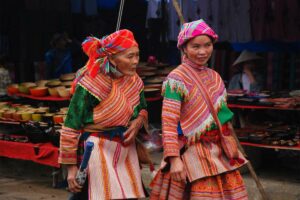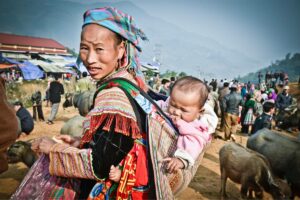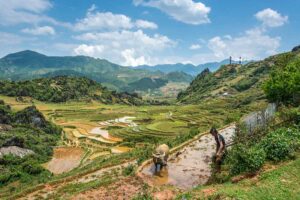Located in the Lao Cai province, not too far from Sapa, Coc Ly Market offers a unique glimpse into the lives of the Tay, Nung, Dao, and Mong ethnic minorities. This vibrant market, held every Tuesday, is an essential gathering place for these communities.
What to expect on Coc Ly Market
Coc Ly market is held on every Tuesday. Although Coc Ly market size is not too large, this market is very meaningful and quite important for ethnic minorities living here. The name Coc Ly also means the roots of the plum tree, which has not been much affected by tourism.
A Vibrant Display of Culture

The market attracts various ethnic groups, including the Tay, Nung, Dao, and Mong. Each group has its distinct cultural heritage and traditional attire. The Tay and Nung are known for their farming practices and live in stilt houses. The Dao and Mong, renowned for their intricate embroidery and weaving, often reside in the higher mountainous regions. One of the first things you’ll notice is the vivid traditional costumes worn by the young men and women, adding a burst of color to the scene.
Hmong girls, in particular, stand out with their beautiful dresses and graceful umbrellas. They often gather near the bridge to showcase their attire and perhaps find potential partners.
A Social Hub
Coc Ly Market is more than just a place for trade. It serves as a social gathering where friends, families, and acquaintances come together to socialize, gossip, and enjoy drinks. This communal aspect makes the market bustling and lively, creating a unique atmosphere that sets it apart from other markets.
Sections of the Market
Coc Ly Market is well-organized, with distinct sections for various types of goods:
Forest & Local Products
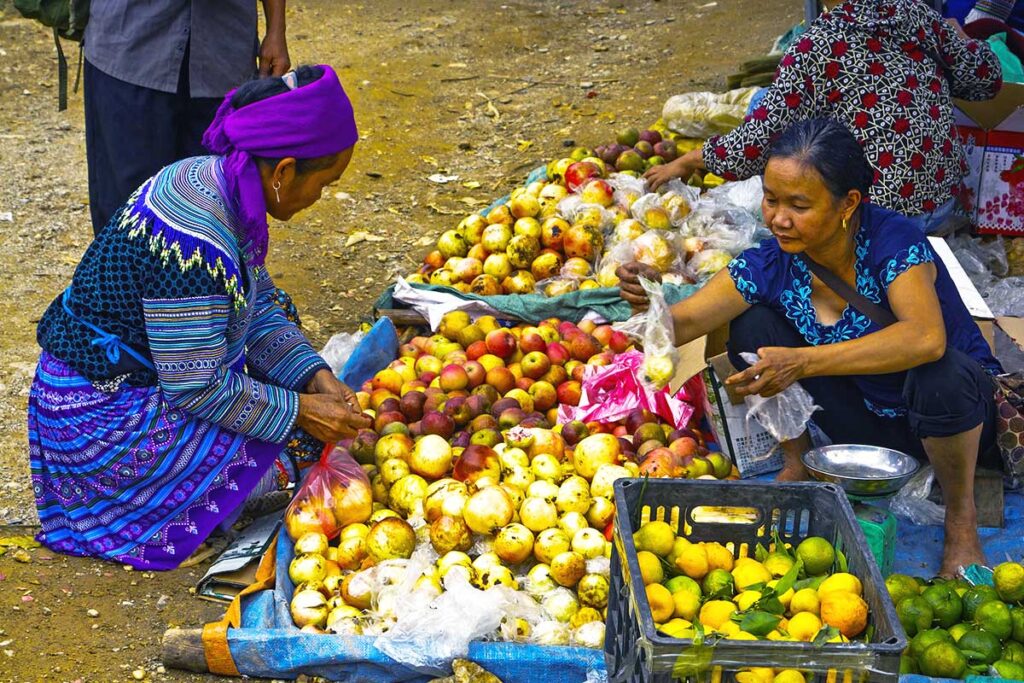
This section is a treasure trove of regional specialties, including upland rice, corn wine, fresh produce, and local meats.
Household Utensils and Jewelry
Here, you’ll find a mix of handmade and imported goods, ranging from practical kitchenware to eye-catching jewelry. For many locals, this is their only opportunity to stock up on essential household items.
Food Court
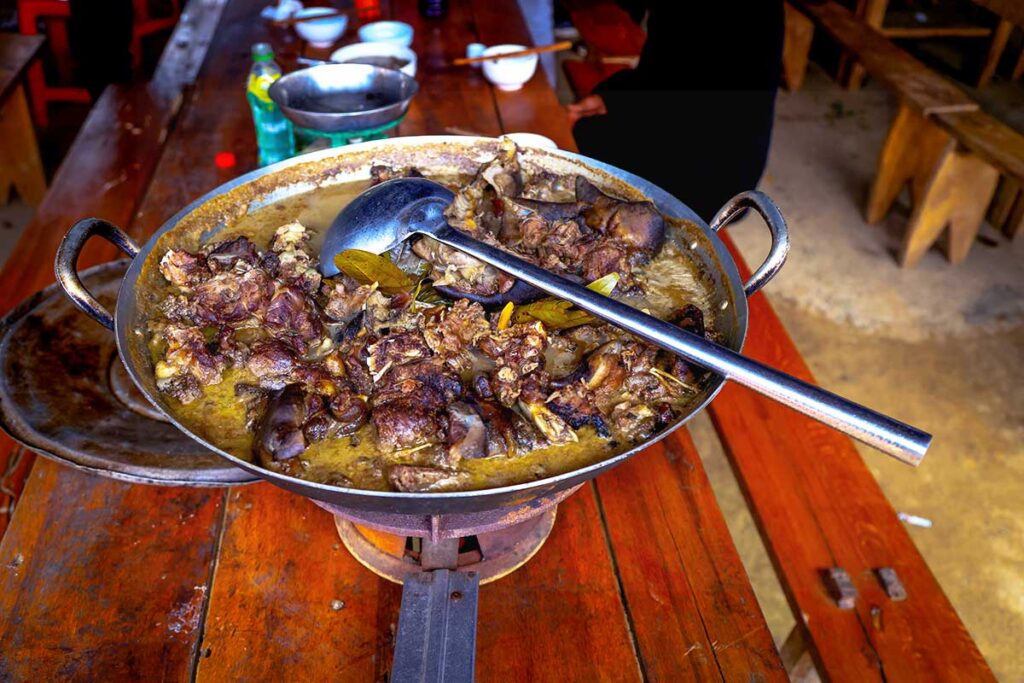
The aroma of sizzling meats and fragrant spices fills the air in this section. You can sample local delicacies like black pork, ‘thang co’ (a hearty meat stew), and ‘men men’ (a steamed cornmeal dish), all prepared fresh on the spot. This is also where locals gather to chat and enjoy a drink together.
Cattle and Poultry

This lively section is the heart of the market, where the bargaining is most intense. You’ll see everything from buffaloes, cows, pigs, ducks, and chickens, all being carefully inspected and haggled over. Be prepared for a bit of a muddy experience, but it’s an incredible sight to behold.
Sapa’s Hilltribe Markets
Coc Ly Market is just one of the many vibrant markets around Sapa. Each market has its unique charm and serves as a gathering place for different ethnic groups. Most markets open only one day a week, making them special events for both locals and visitors.
Other Markets Around Sapa
- Bac Ha Market (Sunday): One of the largest and most famous markets, known for its variety and size.
- Can Cau Market (Saturday): Smaller but very colorful, located near the Chinese border.
- Muong Hum Market (Sunday): Known for its scenic setting and traditional goods.
- Sin Cheng Market (Wednesday): A bit off the beaten path, offering a more authentic experience.
Visiting Coc Ly Market Market
When is the Coc Ly Market?
Coc Ly Market is held every Tuesday. It starts early in the morning and begins to quiet down by noon, so plan to arrive early to experience the full hustle and bustle.
Location
Coc Ly Market is located in Bac Ha District, near the Chay River, in a mountainous area about 70 kilometers from Sapa.
How to Get There
Most visitors make a day trip from Sapa, as there are few accommodations near the market. The mountain roads can be challenging, so the trip from Sapa typically takes about 2.5 hours each way. It’s essential to leave early to ensure you arrive in the morning when the market is most active.
Private car or private tour
This is the best option. Arrange a car or a tour with an English-speaking guide who can also show you around the region.
Tip: We from Local Vietnam can arrange this for you. Just contact us here or check our Sapa market tours here.
Driving motorbike
Not highly recommended unless you are experienced and have a valid motorbike license. Consider finding a homestay closer to the market to avoid the long round trip in one day.
Exploring Coc Ly Commune in Ba Ha District
Beyond Coc Ly Market, Bac Ha District offers a fascinating glimpse into rural Vietnamese life. Imagine picturesque rice terraces cascading down mountains, alongside the winding Chay River. Here, you’ll find remote villages with traditional wooden stilt houses, surrounded by fields and livestock. A boat trip along the river reveals towering limestone cliffs, bamboo groves, and hidden waterfalls. You might even spot local fishermen or water buffalo cooling off.
This mountainous region is perfect for adventurous travelers. While most areas are accessible by road, you can hike to remote waterfalls and viewpoints with a local guide. Don’t miss the chance to visit local villages and experience their unique customs and traditions. Witness traditional crafts, try the local food, or even stay overnight in a homestay. This region is off the beaten path, so be prepared for basic facilities and limited transportation. However, the authentic and unspoiled experiences you’ll have make it all worthwhile.
Tips for visiting the market
- Travel Time: The round trip from Sapa takes almost 5 hours, so plan accordingly.
- Respect Local Cultures: The people are very traditional, so be mindful and respectful of their customs and way of life.
- Photography: Always ask for permission before taking photos.
- Other Markets: If Coc Ly Market doesn’t fit your schedule, check out other markets around Sapa.
- Advance Arrangements: Plan your visit in advance to ensure you can arrange transportation and a guide if needed.
- Comfortable Shoes: Wear sturdy, comfortable shoes for walking around the market.
- Souvenirs: While primarily a local market, you can find traditional brocades and other items that make unique souvenirs.
- Bring Cash: There are no ATMs at the market, so bring enough cash for purchases and food.
